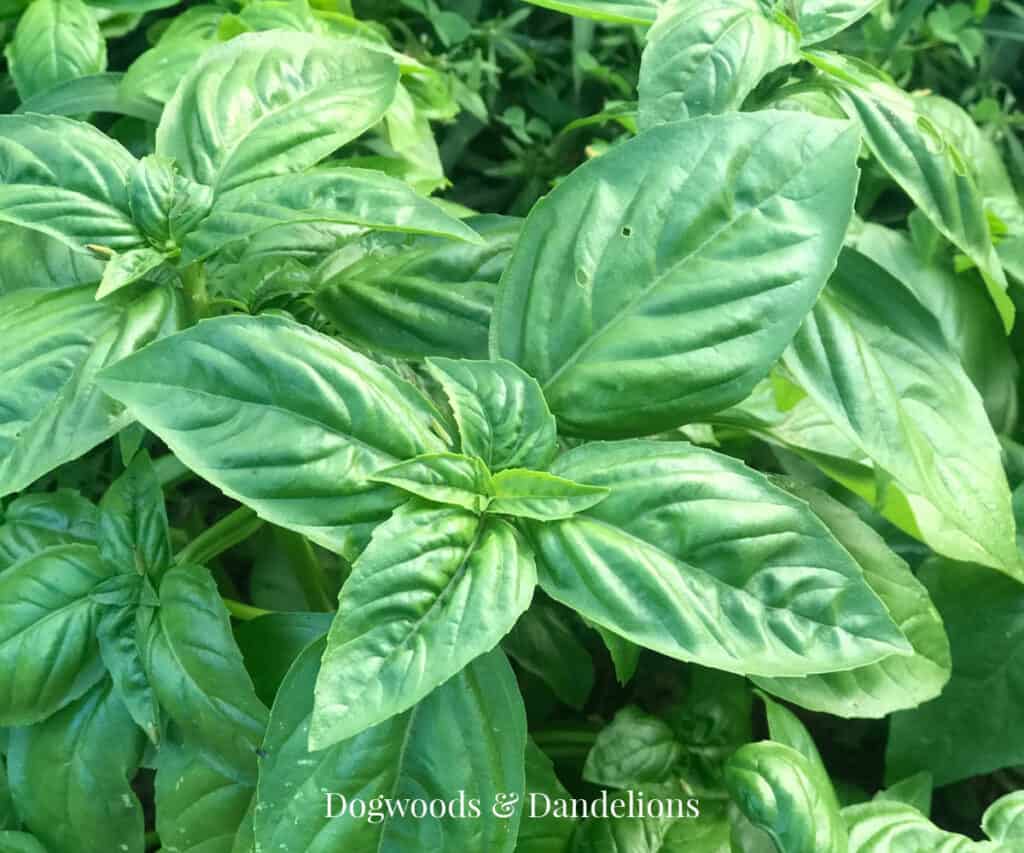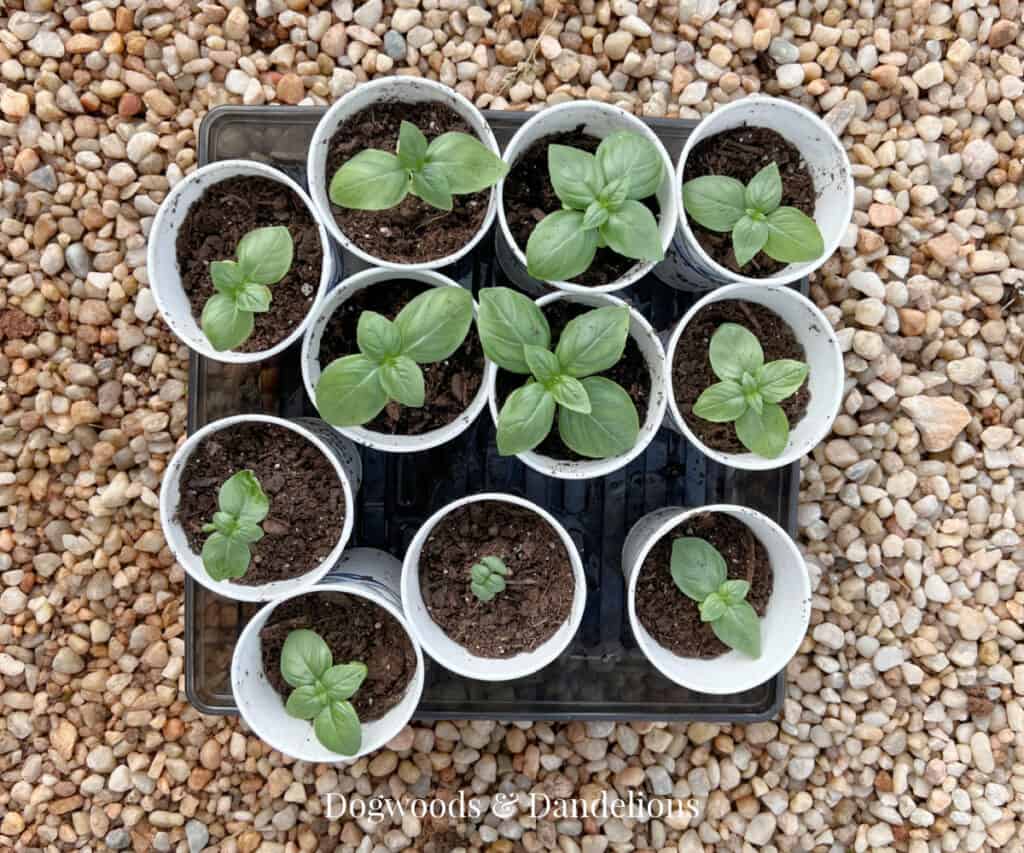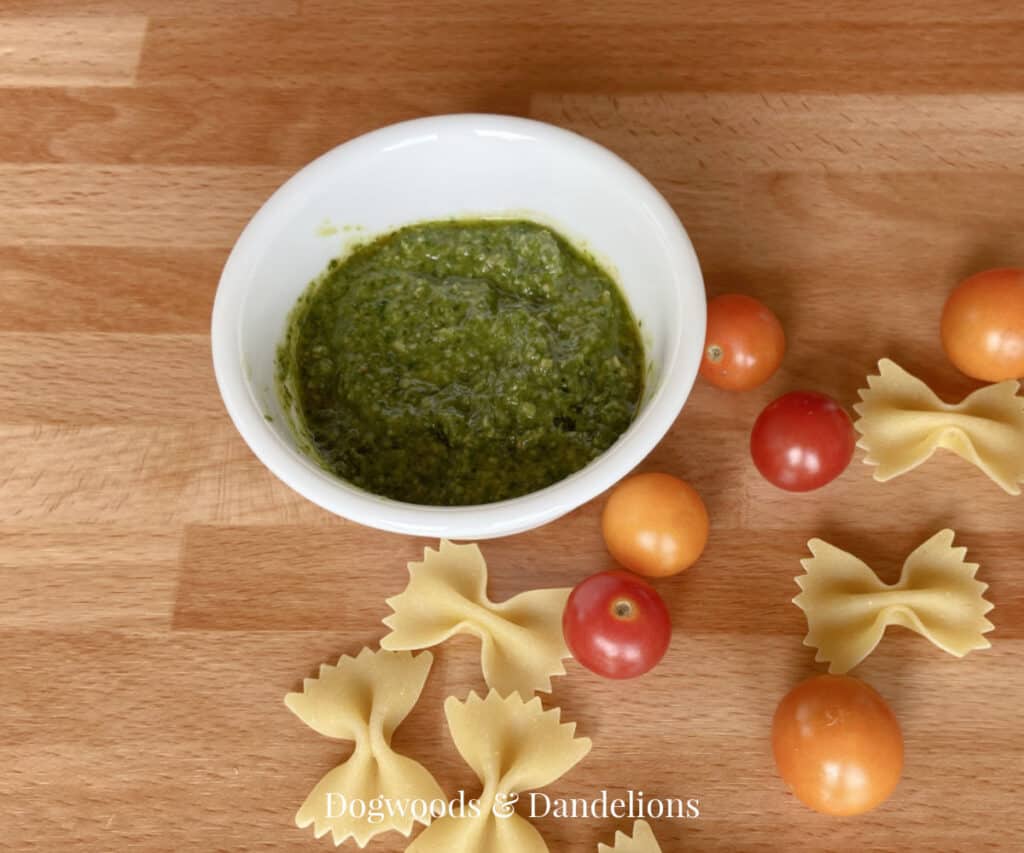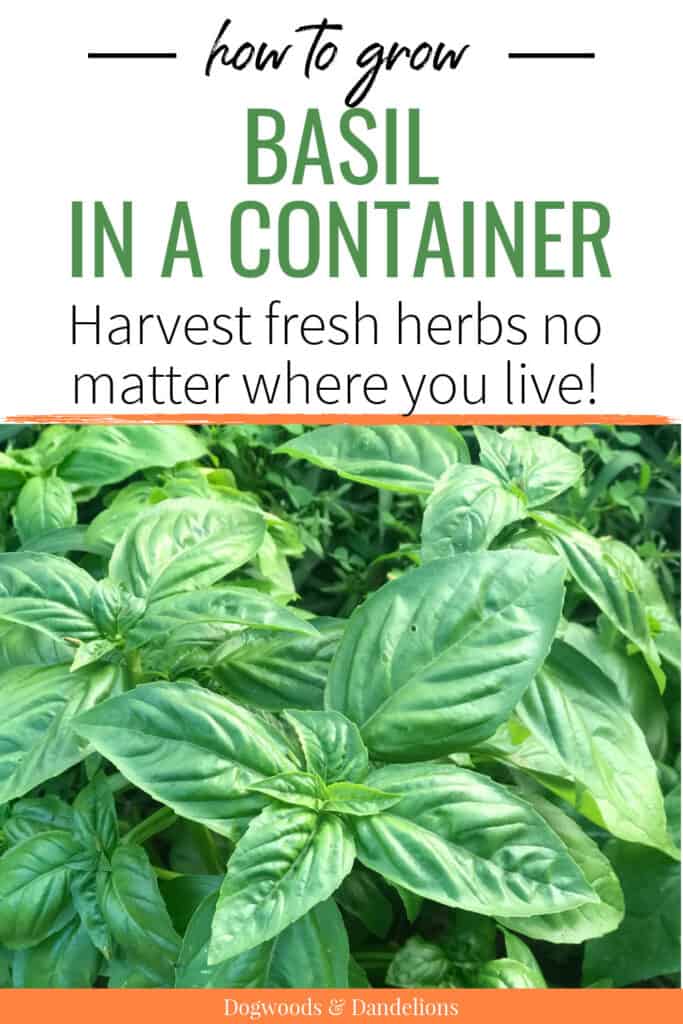How to Grow Basil in Containers
Basil is one of the most popular herbs everyone wants to grow. But what to do if you don’t have space for a large garden? Learn how to grow basil in containers so you can have fresh herbs no matter where you live.

Affiliate Disclosure: Please note that some of the links in this article may be affiliate links and I may receive a small commission if you purchase something through a link. It will not change your cost. As an Amazon Associate, I earn from qualifying purchases. For more information, see my disclosures page.)
Why Grow Herbs?
If you’ve never grown a garden before, growing a few herbs in a pot indoors or on the back deck is a great way to get started gardening. And basil is one of the easiest herbs for a beginning gardener.
Herbs such as basil tend to tolerate poor soil well and often don’t require as much fuss and care as vegetables and flowers.
And a few fresh herbs can really elevate your cooking. Think of a plain roasted chicken breast. Pretty boring right? But add some fresh herbs and you’ve got a meal worthy of serving to company.
For many people, growing a few herbs is a great way to determine whether or not you like gardening. Growing herbs doesn’t require a huge time or cost commitment and growing herbs can actually save you money.
For the price of a small bunch of herbs at the grocery store, you can have loads of fresh herbs for recipes and extra that you can dry or freeze to save for later.
If you grow the herbs yourself you can grow them without pesticides and chemicals so they can truly be organic. And quite a few herbs are perennials so you can buy one plant and harvest herbs for years and years.
I would also like to say that I feel that herbs grown in my own garden taste better than what I buy at the store. Maybe it’s my imagination but I firmly believe they taste better.
And of course, they are always fresher as I usually harvest them just before I cook the meal. I’ve even been known to run to the herb garden in the middle of cooking if I need a pop of flavor for a particular dish.
If you’ve never grown any kind of garden, a small container of basil or another herb is a great way to get started growing some of your own food. You can even grow several different varieties together in the same pot to save space.
Choose Your Location
The first thing to decide is where to locate your basil container. Most herbs do best in full sun which means 6+ hours of sunlight each day. However, many will actually benefit from afternoon shade in the hottest part of the day.
So choose a sunny spot on your porch or deck, or even in your yard that receives a good bit of sun each day.
Another thing to consider when growing basil in containers is to try to locate the containers near a water source. It’s really no fun to have to haul buckets of water long distances during the hot summer months.
Choosing a Container to Grow Basil
You can spend a great deal of money on fancy, self-watering containers to match your landscape décor. But you can also find free or inexpensive containers that will easily hold a few basil plants.
Be sure that any container you plan to use has drainage holes. If not, you will want to add some.
I don’t recommend heavy concrete containers with no drain holes for growing herbs. Most herbs don’t like “wet feet” (wet roots) so allowing the containers to drain will go a long way to making sure your plants are happy.
And concrete containers are difficult to move if you decide to move your basil plant or bring it indoors for the winter.
Another option for growing basil is using a grow bag. There are many on the market today and most have handles so they are easily moveable.
These are my favorite grow bags. I’ve had some that I’ve been using for quite a few years and they are still holding up nicely.
How to Fill Your Containers
You will need to fill your containers with good-quality potting soil. Don’t go out back and dig up dirt from your yard.
The quality of your soil is the most important thing you can do to ensure your basil plants get off to a good start.
When looking for quality potting soil, it should contain perlite or vermiculite to help hold water. I also recommend an organic soil that already contains fertilizer.
Your basil will have to rely on the soil for all its nutrient needs so spend the money on quality soil. You won’t regret it.
Buying Basil Plants vs. Starting Basil From Seed
While basil is fairly easy to start from seed, I do recommend buying plants the first time growing it unless you are an experienced gardener. If you don’t already have an indoor grow light and space set up for starting seeds, it will cost more to acquire the setup than it would to purchase a few plants.

However, if you have a long growing season, you can start the basil seeds outdoors directly in the container you plan to grow them in after all danger of frost has passed.
When purchasing plants, look for plants with sturdy stems, moist soil, and healthy-looking leaves. Be sure to check the roots for bugs and to be sure the plant isn’t root-bound.
Since basil is an annual herb it should be planted outdoors after your last expected frost date. It is a good idea to wait another 2 weeks or so before planting the basil outside if there is any temperatures below freezing in the 10 day forecast.
Basil is very sensitive to frost, and any below freezing temperatures will likely damage the plant or even kill it.
Don’t know your frost dates? This website will give you your frost date based on your zip code. Keep in mind, this is the AVERAGE last expected spring frost. You can still have below-freezing temperatures after this date.
Growing Conditions
If starting seeds indoors, plant basil seeds 4 – 6 weeks before your last frost date. As with most seeds you start indoors, basil needs to be started under grow lights unless you have a sunny windowsill that receives 6 – 8 hours of sunlight each day.
Don’t know your average first and last frost dates? You can look them up by zip code here.
Once the basil plants get their first true leaves, you can pot them up into larger containers if needed.
If you are just beginning to grow a garden, you might want to consider purchasing one or two plants from your local garden center instead of starting basil from seed. Basil is very prolific so one or two plants will likely provide you with all the basil you need unless you plan to preserve lots of it.
Plant your basil in the container at the same depth it was in the original container. Be sure to use a quality potting soil mix that contains either vermiculite or perlite. Digging up garden soil from your yard usually will not provide all the nutrients your container plants will need.
Basil likes full sun so place your container in a sunny spot where it will receive at least 6 hours of sunlight each day. Keep the soil moist, but not overly wet as basil prefers well-drained soil.
If the plants aren’t as bushy as you would like, cut the basil stems back several inches. In a couple of weeks new leaves should appear where you made the cuts.
Fertilize basil about once a month using a diluted liquid fertilizer or granulated organic fertilizer.
Basil is a tender annual which means it is very frost-sensitive and the least bit of frost will likely kill it. It can grow from 1 ½ feet up to 6 feet, depending on the variety and growing conditions.
The hardest part of growing basil is keeping it from flowering. Harvest regularly to prevent flower buds from forming. Once basil starts to flower, the leaves can turn bitter (though they don’t always.) In my zone 7 garden, I have to cut it back almost weekly.
How to Harvest Basil
Cut leaves from the basil plants regularly, even if you can’t use them all. This will help to keep your basil plants from flowering.
The best time to harvest basil is early in the morning after the dew has dried on the plants.
At the end of the growing season, you’ll want to harvest any remaining basil before your first fall frost.
How to Use Basil
Basil has many culinary uses. It is the herb of choice for serving with tomatoes, especially caprese salad, but it also shines in pesto, vegetable salads, on grilled cheese, pizza, or in soups, spaghetti sauces, tomato sauce, and many pasta dishes.
Chop up some fresh basil leaves to add to your garlic bread or sprinkle a few whole leaves over your grilled chicken breast. There are so many uses for homegrown basil.
Ways to Preserve Basil
Basil can be preserved many ways. You can make herb butters and freeze them for later use. You can also chop the aromatic leaves and freeze in ice cube trays covered in olive oil or water.
Basil can be dehydrated or dried by tying small bunches together and hanging it upside down in a dark, warm place for several weeks.

You can also make pesto to freeze for later. Note that if you freeze just the basil leaves by themselves, they will turn black, but they are still safe to eat.
Basil Varieties to Try
Most people are familiar with the standard green basil, usually known as sweet basil (Ocimum basilicum), but there are so many unique varieties of basil (60+ cultivars), each with a different flavor profile.
Lemon basil (Ocimum x citriodorum) has a strong lemon flavor, cinnamon basil (Ocimum basilicum ‘Cinnamon’) has purple stems and a spicy flavor, while Thai basil (Ocimum basilicum ‘Horapha’) has a more licorice taste.
There are compact varieties of basil for small spaces and varieties that are more reluctant to flower, providing you with more time to harvest before it turns bitter. There is even a purple basil variety!
Don’t be afraid to experiment with unique basil varieties if you have room in your container. You can plant multiple types of basil in a single pot if it is large enough.
Given the right conditions, you can expect a bountiful harvest from your basil plants. It’s easy to see why basil is such a popular herb because it is easy to grow and the flavor is much better than those clam-shell packages of fresh basil they sell in grocery stores.
Don’t forget to preserve your basil by drying, dehydrating, or freezing. You may never spend the money on those bland bottles of dried basil at the store again!
Related Posts
- 10 Best Herbs for Beginners to Grow
- How to Grow an Indoor Herb Garden
- Annual vs. Perennial Herbs: What’s the Difference?

